Project Management Assignment: Installing Double-Glazed Glass Windows At Homes In Melbourne
Question
Task:
In this project management assignment, you are required to choose a decision-making situation about a project. The student needs to study the literature and find the best practice to analyses the situation with rationale. The team is required to focus on cost consideration, project delivery and execution from the perspective of sustainability, estimate cash-flow items both inflows and outflow for each alternative. The bases of estimations for estimates should be given. The team needs to decide about interest rate, project life, and other parameters that can affect economic analysis in this activity and apply one of the techniques to evaluate each alternative and select the best one. The student should finalize results of their last part of this assessment and conduct a sensitivity analysis for the case project. For sensitivity analyses, parameters should be selected, and scenarios of sensitivity analyses should be defined accordingly. For each scenario, the economic analysis should be done, and results should be compared and explained. The student should also provide parameters for due diligence processes and the information needs of stakeholders and supporters of the project.
Answer
Introduction
The project management allows the organizations and project teams to plan and execute the project in a very effective and efficient manner. Planning is one of the most crucial aspects of a project as the majority of the project fails due to lack of effective planning. The project management assignment highlights the importance of effective decision making in projects, the study covers a project that aims to install a double-glazed glass window at homes for energy efficiency. The project would be conducted in the City of Melbourne if confirmed. The benefits of the project have also been explained in the study.
Project Aim
The aim of the project is to install double glazed glass windows at homes for energy efficiency. As per the new Australian Government Policy, people and industries have to focus on renewable energy in order to address the environmental impact on climate change.
Project Objectives
Following are the objectives:
- To unmount all the existing windows in all the homes present in Princess Hill
- To install double glazed glass window in all the homes present in Princess Hill
- To analyse the benefits of the through economic and sensitive analysis
- To recommend the project to the government
Project Strategy
One of the major reasons for climate change is the use of non-renewable energy. It is every individual's responsibility to support and protect the environment. The project has been intended to improve and support the environment by replacing the ordinary windows with the double glazed glass windows in all the houses of Princes Hill. The double glazed windows are the ideal energy-efficient source that could add benefits of minimizing noise. The air is sealed between the glasses and adds a layer of insulation. The added thermal resistance reduces the total amount of heat escaping in the winter and keeps the house at a more comfortable temperature. The reason for selecting Princes Hill is that the temperature is lower in that area and the use of non-renewable energy to produce heat is higher in that area. The new windows would lower the use of room heaters and hearth. There are a total of 1018 houses in Princes Hill. On an average, there are six windows in every home. The project is scheduled to change all the windows in six months' duration.
Project Schedule
The total time required to change all of the windows in the Princess Hill would be 6 months. All of the documentation, planning, procurement and execution process would be done in this six months time period. Following is the schedule for Project Princess Hill.
|
Project Princes (6 months) |
|||
|
Task Name |
Duration |
Start |
Finish |
|
Initiation |
15 days |
01/06/2020 |
15/6/2020 |
|
Planning |
30 days |
16/6/2020 |
16/07/2020 |
|
Execution |
75 days |
17/07/2020 |
01/10/2020 |
|
Control |
30 days |
02/10/2020 |
02/11/2020 |
|
Closing |
30 days |
04/11/2020 |
04/12/2020 |
Table 1: Project Schedule
(Source: Created by the learner)
Project Cost
As the project is intended to change all of the windows in the Princess Hill, some assumptions have been made in the project. The biggest assumption that has been made is based on certain records and information. The average window in the home has been considered to 6. The cost of installing a double glazed window in Prince Hill is $ 200 excluding the labour charge.
Total Number of houses in Princess Hill: 1018
Average Windows in every home of Princess Hill: 6
Total Number of Windows that needs to replaced in Princess Hill: 1018*6 = 6108
Total cost required for Double Glazed Window: $200*6108= $12, 21,600
Following is the final Project Budget
|
Events |
Cost |
|
Double glazed glass window |
$ 12,21,600 |
|
Labour cost and fitting cost |
$ 10,00,000 |
|
Transportation cost |
$ 5,00,000 |
|
Supervisor compensation |
$ 10,00,000 |
|
Total Cost |
$ 37,21,600 |
Table 2: Project Budget
(Source: Created by the learner)
The final budget for the Project Princess Hill is $ 37, 21,600. The project is intended to be completed within this budget. There is a possibility that the final expense surpasses the project budget. This could also be considered as a project risk. A mitigation strategy needs to be developed to address this cost budget risk. The project manager has to monitor the roses and budget.
Project Performance
The success of the project depends very much on the team performance; the project must deliver the objectives while ensuring the quality. In this project, the ordinary windows are going to be replaced with double glazed glass windows in Prince Hill. This project is intended to support and protect the environment and also to install climate change. The project manager is responsible for managing the project and also to maintain the quality and performance of the project (Pollard, 2019). It has been stated that project performance is dependent on the performance of project managers. The project manager is accountable for monitoring and encouraging the project members so that the project performance could increase. The primary focus on the project is to accomplish the project objectives in the given budget and time. The project manager is going to divide the project in sub-tasks so that the tasks could be assigned to different project members. The project schedule would help the project member to complete that task in the given period of time. The project primarily focuses on making correct decisions for every task, so the project involves the use of economic analysis sensitive analysis (Kerzner, H., & Saladis, 2017).
Cash Flow Diagram
In order to draw the cash flow diagram, simple interest had to be calculated for the project. The project budget is $ 37, 21,600. The total amount is going to be sanctioned by a local bank with an interest rate of 12%. As the project is intended to be completed in six months, the bank has agreed to repay the amount within a year. So following is the simple interest calculation.
Principal: $ 37, 21,600
Time: 1 year
Rate: 12%
Simple Interest = P*R*T/100
Simple Interest = 37, 21,600*12*1/100
Simple Interest = $4, 46,592
Total Repayment = P+SI
Total Repayment = $ 41, 68, 192
Now, the future value for the cash flow diagram needs to be calculated
Future Value = I (1+R) ^
Future Value = $58, 05,696
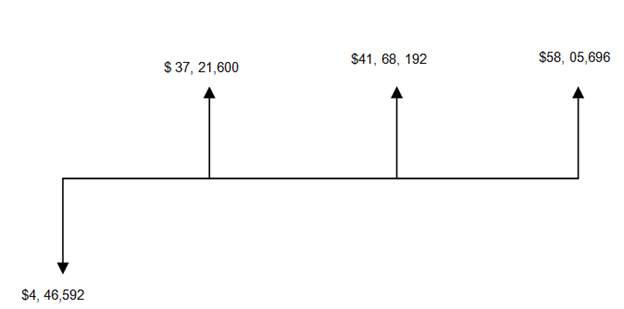
Figure 1: Critical Path Diagram
(Source: Created by the learner)
Economic Analysis
In order to conduct the economic analysis, the problems linked in the project need to be identified and evaluated. Following are the problems that are linked to the project.
Delay in schedule: The project success would be hindered if the project deliverables are completed within the given time frame. The delay in the project could happen through various means. The delay could create a direct impact on the success of the project.
Final expenditure surpassing the actual budget: The project has been allocated with a fixed budget. If the budget surpasses the allocated budget then the deliverables of the project cannot be completed. This risk for problems is of high priority as it could make the project a failure.
Lack of workers performance: The project is intended to maintain the quality which eventually is dependent on the worker’s performance. Lack of workers performance could hinder the quality and project deliverables.
Any health hazard at the project site: There is a possibility of any health hazard at the workplace will create an impact on the health workers and the project schedule.
|
Problems and Risks |
Impact |
Feasible Alternatives |
|
Delay in schedule |
High |
The deadly schedule problem could be mitigated by effective monitoring and schedule. The project manager would be responsible for monitoring the progress of the project. The project is going to be divided into subparts and pages. The project tasks would be allocated to project members.
|
|
Final expenditure surpassing the actual budget |
High |
A financial backup plan is required in case the final expenditure surpasses the project budget |
|
Lack of workers performance |
Medium |
The project manager and site supervisors have to boost confidence and more workers. The rewarding approach could be adopted by the project team. |
|
Any health hazard at the project site |
High |
The possible health hazard needs to analyse and mitigate. In case of any accident or health, the first aid and fast health facility should be available (Varajão, Colomo-Palacios & Silva, 2017). |
Table 3: Economic and Risk Analysis
(Source: Created by the learner)
Sensitive Analysis
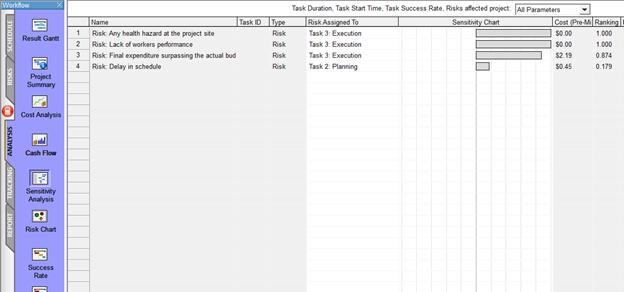
Figure 2: Sensitive Analysis
(Source: Created by the learner)
Work Breakdown Structure
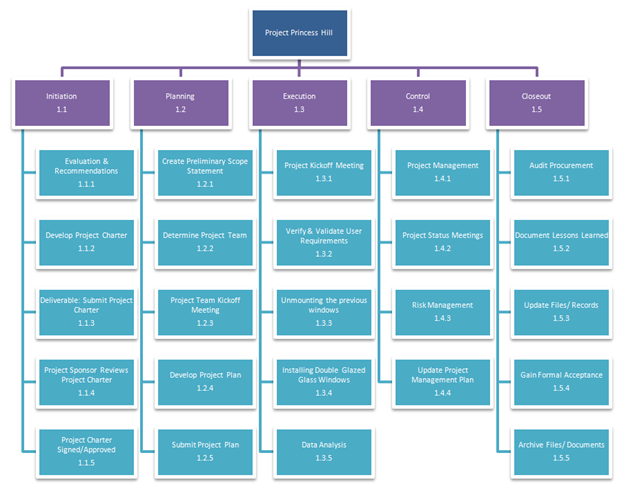
Figure 3: WBS
(Source: Created by the learner)
Gantt chart
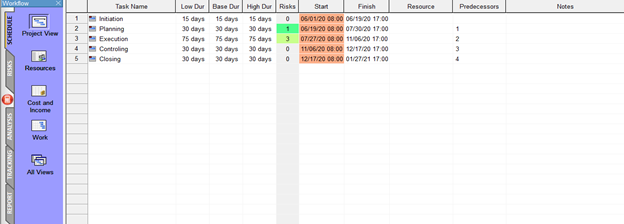
Figure 4: Gantt chart
(Source: Created by the learner)
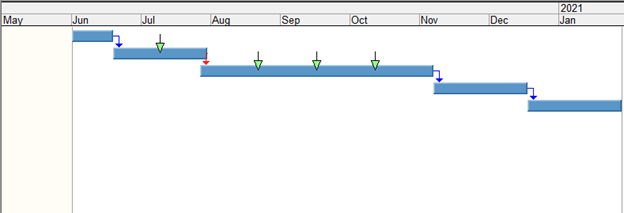
Figure 5: Gantt chart
(Source: Created by the learner)

Figure 6: Gantt chart
(Source: Created by the learner)
Risk Register
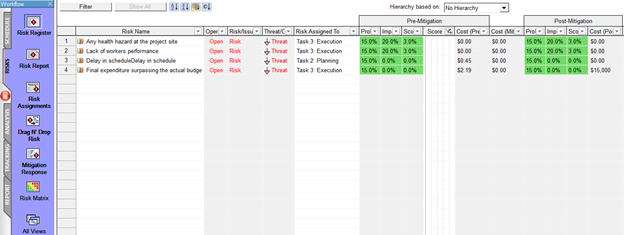
Figure 6: Risk Register
(Source: Created by the learner)
Assumptions
Following are the assumptions in the project:
- Assuming average windows to be 6 in every home
- The schedule could be revised in the future
- The budget could also be revised
- The quality management process could also be revised
Stakeholders
The stakeholders of the Project Princess Hill are:
- Project Manager
- Project Supervisor
- Site Supervisors
- Team Leader
- Site workers
- Local Bank
- House Owners in Princess Hill
- Government
Communication Plan
|
Form |
Stakeholders |
Frequency |
Method |
Discussion |
|
Initial Meeting |
Project Team |
Once |
Meeting |
To finalize the schedule and budget |
|
Announcement Meeting |
Project Team |
Once |
Meeting |
To start the project |
|
Status of the project |
Project Team |
Daily |
|
To understand the project status |
|
Project audit |
Analyst and Project Team |
Frequently |
Meeting |
To evaluate the progress and resources |
|
Closing Meeting |
Project Team |
Once |
Meeting |
To finish the project and create the final documents and reports (Auerbach., Daniels, & Urban, 2019) |
Table 4: Communication Plan
(Source: Created by the learner)
Reasons for recommending the project
The project is going to support and contribute to the environment and the project is also going to allow people and the government to control the climate to=change. The project would allow people lower the use of non-renewable energy/ People in Princess Hill would lower the use of room heaters and wood fireplaces that are built inside homes. The double-glazed glass window would work as insulated and maintain comfortable room temperature. The project is going to continue to the environment and the government and people need to consider this project. The process would be completed within six months. The possible risks could also be mitigated with a specific budget.
Conclusion
It could be concluded that the project is going to support the environment and it would also lower the use of non-renewable energy. The project is going to be completed in six months. There are few risks linked to the project which could be easily imitated. Maintaining the quality of the project is the primary goal.
Reference List
Auerbach, S. W., Daniels, A. S., & Urban, D. R. (2019). U.S. Patent No. 10,496,942. Washington, DC: U.S. Patent and Trademark Office. Retrieved on: 21 of April 2020, from: https://patentimages.storage.googleapis.com/b3/e5/be/6b8c7dada6d4af/US20160260048A1.pdf
Kerzner, H., & Saladis, F. P. (2017). Project management workbook and PMP/CAPM exam study guide. John Wiley & Sons. Project management assignment Retrieved on: 21 of April 2020, from: https://books.google.com/books?hl=en&lr=&id=-oGcDgAAQBAJ&oi=fnd&pg=PR11&dq=project+management&ots=m42HWqW1KO&sig=Wrkivs4B-rvr6uiYDl4HNuJG7Gs
Pollard, C. E. (2019). Lessons learned from client projects in an undergraduate project management course. Journal of Information Systems Education, 23(3), 3. Retrieved on: 21 of April 2020, from: https://books.google.com/books?hl=en&lr=&id=duGGDwAAQBAJ&oi=fnd&pg=PT7&dq=project+management&ots=bga8CFu8x3&sig=0VERDL21KfKQzfqdXsGjbf3ZjmQ
Varajão, J., Colomo-Palacios, R., & Silva, H. (2017). ISO 21500: 2012 and PMBoK 5 processes in information systems project management. Computer Standards & Interfaces, 50, 216-222. Retrieved on: 21 of April 2020, from: http://ism.hiof.no/papers/290.pdf












